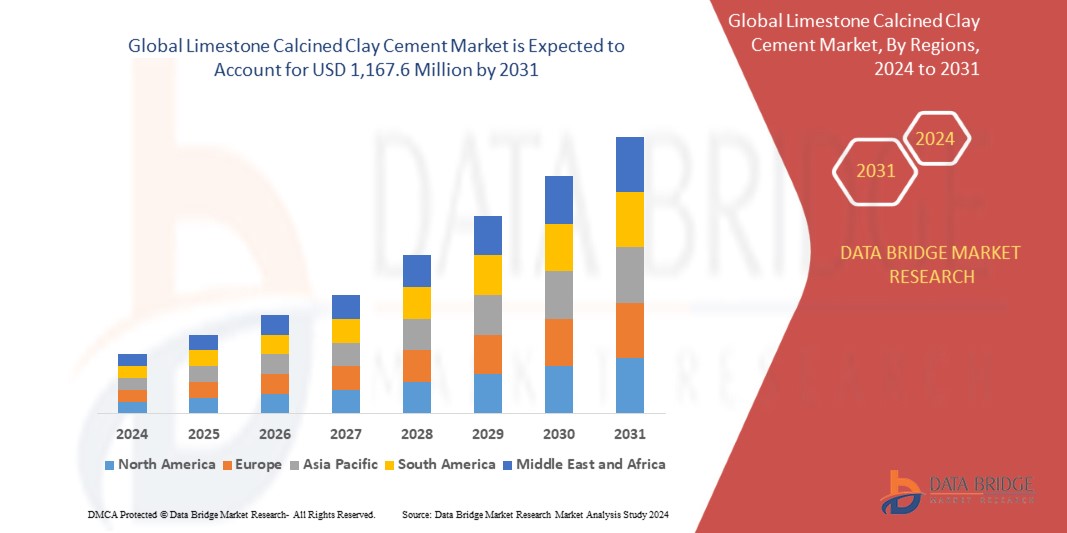世界の石灰石焼成粘土セメント市場
Market Size in USD Billion
CAGR :
% 
| 2024 –2031 | |
| USD 722.40 Million | |
| USD 1,167.60 Million | |
|
|
|
世界の石灰石焼成粘土セメント市場、製品タイプ別(LC3 混合セメント、LC3 コンクリート、LC3 モルタル)、用途別(住宅、商業、工業)、エンドユーザー別(建設、インフラ、その他)、クリンカー代替率別(低代替(15~30%)、中代替(30~50%)、高代替(50% 以上))、流通チャネル別(セメントサプライヤー、建設資材販売業者、小売店) - 2031 年までの業界動向と予測。
石灰石焼成粘土セメント市場の分析と規模
予測期間中に石灰石焼成粘土セメント市場の成長を後押しすると予想される主な要因は、環境問題に対する世界的な意識の高まりが持続可能な建設資材の需要の増加を牽引していることです。さらに、業界関係者、研究機関、政府機関間の協力的な取り組みは、石灰石焼成粘土セメント市場にとってのチャンスとなります。一方、初期設置コストと技術的課題が市場の成長を妨げると予想されます。
データブリッジマーケットリサーチは、2023年に7億2,240万米ドルだった石灰石焼成粘土セメント市場は、2031年までに11億6,760万米ドルに達すると予測しており、2024年から2031年の予測期間中に6.2%のCAGRを達成すると予想されています。石灰石、焼成粘土、クリンカーを組み込んだ混合セメントはLC3市場で一般的なタイプであるため、「LC3混合セメント」が市場の製品タイプセグメントを支配しています。石灰石と焼成粘土によるクリンカーの代替の割合は変化する可能性があり、セメントの環境特性と性能特性に影響を与えます。
データブリッジマーケットリサーチがまとめた市場レポートには、市場価値、成長率、セグメンテーション、地理的範囲、主要企業などの市場シナリオに関する洞察に加えて、専門家による詳細な分析、地理的に表された企業別の生産量と生産能力、販売業者とパートナーのネットワークレイアウト、詳細かつ最新の価格動向分析、サプライチェーンと需要の不足分析も含まれています。
レポートの範囲と市場セグメンテーション
|
レポートメトリック |
詳細 |
|
予測期間 |
2024年から2031年 |
|
基準年 |
2023 |
|
歴史的な年 |
2022 (2016~2021年にカスタマイズ可能) |
|
定量単位 |
売上高(百万米ドル)、販売数量(個数)、価格(米ドル) |
|
対象セグメント |
製品タイプ別(LC3 混合セメント、LC3 コンクリート、LC3 モルタル)、用途別(住宅、商業、工業)、エンドユーザー別(建設、インフラ、その他)、クリンカー代替率別(低代替(15~30%)、中代替(30~50%)、高代替(50% 以上)、流通チャネル別(セメントサプライヤー、建設資材販売業者、小売店) |
|
対象国 |
米国、カナダ、メキシコ、ブラジル、アルゼンチン、その他の南米諸国、ドイツ、フランス、イタリア、英国、ベルギー、スペイン、ロシア、トルコ、オランダ、スイス、その他のヨーロッパ諸国、日本、中国、インド、韓国、オーストラリア、シンガポール、マレーシア、タイ、インドネシア、フィリピン、その他のアジア太平洋諸国、UAE、サウジアラビア、エジプト、南アフリカ、イスラエル、その他の中東およびアフリカ諸国 |
|
対象となる市場プレーヤー |
HOLCIM(スイス)、HeidelbergCement(ドイツ)、CEMEX(メキシコ)、CRH(アイルランド)、Anhui Conch Cement Co., Ltd.(中国)、China National Building Material Group Corporatio(中国)、TAIHEIYO CEMENT CORPORATION(日本)、UltraTech Cement Ltd.(インド)、Dangote Cement Plc.(ナイジェリア)、Buzzi SpA(イタリア)、Votorantim Cimentos(ブラジル)、EUROCEMENT group.(ロシア)、TITAN CEMENT(ギリシャ)、SCG(タイ)、SSANGYONG C&E(韓国)、Shree Cement Limited(インド)、COLACEM(イタリア)、Grupo Argos SA(コロンビア) |
|
市場機会 |
|
市場の定義
石灰石焼成粘土セメント (LC3) は、従来のポートランドセメントに代わる環境に優しい代替品として設計された革新的で持続可能な建築資材です。セメント製造プロセスに焼成粘土と石灰石を組み込むことで配合された LC3 は、二酸化炭素排出量とエネルギー消費を大幅に削減します。クリンカー含有量が少ないことで知られる LC3 は、建設に必要な基本的な特性を維持しながら環境の持続可能性に貢献し、建設業界の環境影響を削減する世界的な取り組みにおいて極めて重要なソリューションとなっています。
石灰石焼成粘土セメント市場の動向
ドライバー
- 環境問題への配慮から持続可能な建設資材の重要性が高まっている
環境の持続可能性は、石灰石焼成粘土セメント (LC3) 採用の重要な推進力です。LC3 は、従来のポートランド セメントと比較して、製造時の二酸化炭素排出量を大幅に削減し、建設資材の環境への影響を軽減する世界的な取り組みに合致しています。クリンカー含有量の低さと焼成粘土の使用は、LC3 の環境に優しいプロファイルに貢献し、持続可能な建設慣行における好ましい選択肢となっています。
LC3 の環境持続可能性は、生産プロセスにおけるエネルギー消費を最小限に抑える能力によってさらに強調されます。クリンカー生産に必要な温度が低いため、LC3 は全体的なエネルギー需要を削減し、より資源効率が高く環境に配慮した代替品となります。世界中の建設業界がより環境に優しい建築手法を優先する中、LC3 の固有の環境上の利点は、環境に配慮した低炭素フットプリントの建設資材への移行の重要な推進力として位置付けられています。
- 持続可能な建築慣行を促進する厳しい規制と政府のインセンティブ
多くの政府は、持続可能な建設資材の使用を奨励する厳しい環境基準と建築基準を実施しています。LC3 の低炭素フットプリントはこれらの規制に準拠しており、環境に優しい建設慣行に準拠するための好ましい選択肢として位置付けられています。
規制に加えて、さまざまな政府が環境に優しい建設資材の使用を促進するために、財政的なインセンティブや補助金を提供しています。これらのインセンティブには、税制優遇、助成金、またはリベートが含まれる場合があり、建設業者や開発業者が LC3 を採用するのに有利な経済環境を作り出しています。世界中の政府が持続可能な開発に重点を置くようになると、これらの規制とインセンティブは、建設業界で LC3 が広く採用されるよう推進する強力な原動力となります。
機会
- 政府、産業界、研究機関の協力的な取り組み
関係者が持続可能な建設における石灰石焼成粘土セメント (LC3) の可能性を認識するにつれて、コラボレーションとパートナーシップの機会が生まれます。政府、業界関係者、研究機関間の共同作業により、知識の交換が促進され、LC3 の技術と用途におけるイノベーションが促進されます。戦略的パートナーシップを形成することで、企業はリソースと専門知識を共有し、より広範囲で LC3 の開発、推進、採用を加速できます。
これらのコラボレーションは業界の境界を越えて、建築家、エンジニア、環境保護団体を巻き込み、持続可能な建設への総合的なアプローチを生み出します。共同イニシアチブは、LC3 の認知度と受容を高めるための研究開発、標準化の取り組み、教育キャンペーンに焦点を当てることができます。LC3 セクターでのコラボレーションとパートナーシップの機会は、イノベーションを刺激するだけでなく、建設業界における持続可能な実践を促進する支援的なエコシステムの確立にも貢献します。
制約/課題
- LC3生産への移行や建設プロジェクトへのLC3の組み込みに必要な初期投資
LC3 生産への移行や建設プロジェクトへの LC3 の統合には、新技術への投資や既存の製造プロセスの変更など、多額の初期費用が必要になる場合があります。この財務上の障壁は、資本が限られている小規模建設会社や企業にとって特に困難であり、長期的な持続可能性のメリットがあるにもかかわらず、LC3 を採用する能力を妨げる可能性があります。この制約を克服するには、LC3 への初期投資をより幅広い関係者にとってアクセスしやすく実現可能なものにするための、業界内での的を絞った財務戦略、インセンティブ、または共同作業が必要です。
この石灰石焼成粘土セメント市場レポートは、最近の新しい開発、貿易規制、輸出入分析、生産分析、バリュー チェーンの最適化、市場シェア、国内および現地の市場プレーヤーの影響、新たな収益源の観点から見た機会の分析、市場規制の変更、戦略的市場成長分析、市場規模、カテゴリ市場の成長、アプリケーションのニッチと優位性、製品の承認、製品の発売、地理的拡張、市場における技術革新の詳細を提供します。石灰石焼成粘土セメント市場の詳細については、アナリスト ブリーフについて Data Bridge Market Research にお問い合わせください。当社のチームが、市場の成長を達成するための情報に基づいた市場決定を行うお手伝いをします。
最近の動向
- 2023年10月、Ciments de l'Afrique(CIMAF)は、西アフリカ全域のセメント工場で石灰石焼成粘土セメント(LC3)を製造する予定です。親会社であるOmnium des Industries et de la Promotion(OIP)は、ブルキナファソに焼成粘土生産施設を開発し、材料を供給する予定です。
- 2023年2月、HOLCIMはフランスのサンピエールラクールにヨーロッパ初の焼成粘土セメント工場を開設し、通常のセメント(CEM I)よりも50%低いCO2フットプリントのECOPlanetグリーンセメントを生産します。この革新的な製造ラインは世界初であり、Holcimの特許技術であるproximA Techを使用して、年間最大50万トンの低炭素セメントを生産します。
- 2022年4月、ラファージュ・セメント・マラウイはマラウイでのLC3プロジェクトの開始を発表し、この地域でこの革新的なセメント技術の利用が拡大していることを示した。
- 2020年2月、セメントス・アルゴスは、2020年初頭にコロンビアのリオクラロ工場に新しい焼成粘土生産ライン(年間生産能力45万トン)を完成させると発表した。
世界の石灰石焼成粘土セメント市場の範囲
石灰石焼成粘土セメント市場は、製品タイプ、用途、エンドユーザー、クリンカー代替率、流通チャネルに基づいてセグメント化されています。これらのセグメントの成長は、業界のわずかな成長セグメントを分析するのに役立ち、ユーザーに貴重な市場概要と市場洞察を提供し、コア市場アプリケーションを特定するための戦略的決定を下すのに役立ちます。
製品タイプ
- LC3 混合セメント
- LC3コンクリート
- LC3 迫撃砲
応用
- 居住の
- コマーシャル
- 産業
エンドユーザー
- 工事
- インフラストラクチャー
- その他
クリンカー代替率
- 低い代替性(15~30%)
- 中程度の置換(30-50%)
- 高置換率(50%以上)
流通チャネル
- セメントサプライヤー
- 建設資材販売業者
- 小売店
石灰石焼成粘土セメント市場の地域分析/洞察
石灰石焼成粘土セメント市場が分析され、市場規模の洞察と傾向が、上記の製品タイプ、用途、エンドユーザー、クリンカー代替率、流通チャネル別に提供されます。
市場レポートで取り上げられている国は、米国、カナダ、メキシコ、ブラジル、アルゼンチン、その他の南米諸国、ドイツ、フランス、イタリア、英国、ベルギー、スペイン、ロシア、トルコ、オランダ、スイス、その他のヨーロッパ諸国、日本、中国、インド、韓国、オーストラリア、シンガポール、マレーシア、タイ、インドネシア、フィリピン、その他のアジア太平洋諸国、UAE、サウジアラビア、エジプト、南アフリカ、イスラエル、その他の中東およびアフリカ諸国です。
ヨーロッパ地域は、持続可能な建設手法の導入において先駆者的存在であるため、市場を独占すると予想されています。炭素排出量の削減に重点を置くことは、LC3 の環境的利点と一致しており、この地域の建設プロジェクトにとって LC3 は魅力的な選択肢となっています。
北米は、グリーン ビルディング基準と LEED 認証への関心の高まりにより、市場で最も高い成長が見込まれる地域であり、この地域では LC3 の採用が増加する可能性があります。LC3 の二酸化炭素排出量の削減とエネルギー効率は、建設業界の持続可能性の目標と一致しています。
レポートの国別セクションでは、市場の現在および将来の傾向に影響を与える国内市場における個別の市場影響要因と規制の変更も提供しています。下流および上流のバリュー チェーン分析、技術動向、ポーターの 5 つの力の分析、ケース スタディなどのデータ ポイントは、各国の市場シナリオを予測するために使用される指標の一部です。また、国別データの予測分析を提供する際には、グローバル ブランドの存在と可用性、および地元および国内ブランドとの競争が激しいか少ないために直面する課題、国内関税の影響、貿易ルートも考慮されます。
競争環境と石灰石焼成粘土セメント市場シェア分析
石灰石焼成粘土セメント市場の競争状況は、競合他社ごとに詳細を提供します。含まれる詳細には、会社概要、会社の財務状況、収益、市場の可能性、研究開発への投資、新しい市場への取り組み、世界的なプレゼンス、生産拠点と施設、生産能力、会社の強みと弱み、製品の発売、製品の幅と広さ、アプリケーションの優位性などがあります。提供された上記のデータ ポイントは、石灰石焼成粘土セメント市場に関連する会社の焦点にのみ関連しています。
石灰石焼成粘土セメント市場で活動している主要企業は次のとおりです。
- HOLCIM(スイス)
- ハイデルベルグセメント(ドイツ)
- セメックス(メキシコ)
- CRH(アイルランド)
- 安徽コンクセメント株式会社(中国)
- 中国建材集団公司(中国)
- 太平洋セメント株式会社(日本)
- ウルトラテックセメント株式会社(インド)
- ダンゴート・セメント社(ナイジェリア)
- Buzzi SpA(イタリア)
- ヴォトランティン シメントス (ブラジル)
- EUROCEMENTグループ(ロシア)
- TITAN CEMENT(ギリシャ)
- SCG(タイ)
- 双龍C&E(韓国)
- シュリーセメントリミテッド(インド)
- COLACEM(イタリア)
- Grupo Argos SA (コロンビア)
SKU-
世界初のマーケットインテリジェンスクラウドに関するレポートにオンラインでアクセスする
- インタラクティブなデータ分析ダッシュボード
- 成長の可能性が高い機会のための企業分析ダッシュボード
- カスタマイズとクエリのためのリサーチアナリストアクセス
- インタラクティブなダッシュボードによる競合分析
- 最新ニュース、更新情報、トレンド分析
- 包括的な競合追跡のためのベンチマーク分析のパワーを活用
調査方法
データ収集と基準年分析は、大規模なサンプル サイズのデータ収集モジュールを使用して行われます。この段階では、さまざまなソースと戦略を通じて市場情報または関連データを取得します。過去に取得したすべてのデータを事前に調査および計画することも含まれます。また、さまざまな情報ソース間で見られる情報の不一致の調査も含まれます。市場データは、市場統計モデルと一貫性モデルを使用して分析および推定されます。また、市場シェア分析と主要トレンド分析は、市場レポートの主要な成功要因です。詳細については、アナリストへの電話をリクエストするか、お問い合わせをドロップダウンしてください。
DBMR 調査チームが使用する主要な調査方法は、データ マイニング、データ変数が市場に与える影響の分析、および一次 (業界の専門家) 検証を含むデータ三角測量です。データ モデルには、ベンダー ポジショニング グリッド、市場タイムライン分析、市場概要とガイド、企業ポジショニング グリッド、特許分析、価格分析、企業市場シェア分析、測定基準、グローバルと地域、ベンダー シェア分析が含まれます。調査方法について詳しくは、お問い合わせフォームから当社の業界専門家にご相談ください。
カスタマイズ可能
Data Bridge Market Research は、高度な形成的調査のリーダーです。当社は、既存および新規のお客様に、お客様の目標に合致し、それに適したデータと分析を提供することに誇りを持っています。レポートは、対象ブランドの価格動向分析、追加国の市場理解 (国のリストをお問い合わせください)、臨床試験結果データ、文献レビュー、リファービッシュ市場および製品ベース分析を含めるようにカスタマイズできます。対象競合他社の市場分析は、技術ベースの分析から市場ポートフォリオ戦略まで分析できます。必要な競合他社のデータを、必要な形式とデータ スタイルでいくつでも追加できます。当社のアナリスト チームは、粗い生の Excel ファイル ピボット テーブル (ファクト ブック) でデータを提供したり、レポートで利用可能なデータ セットからプレゼンテーションを作成するお手伝いをしたりすることもできます。





